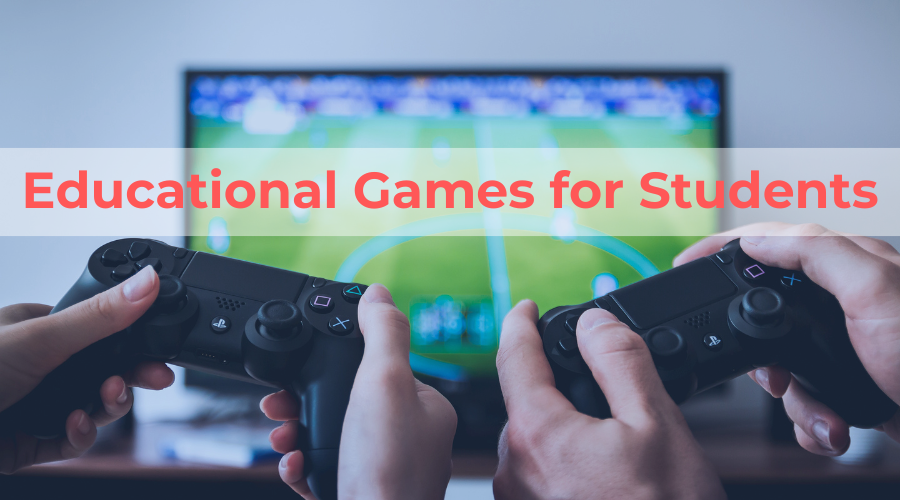When I was younger, the idea of learning through games was something I never really thought about.
Back then, schoolwork was done with books and pencils, and if you were lucky, you might get to play a game on the family computer for 30 minutes.
But now, things have changed. Educational games have become a powerful tool in helping students not only learn better but enjoy the process of learning as well.
I remember when I first introduced educational games to my younger sibling. We were struggling with getting through basic math problems.
No matter how much we practiced with flashcards, it just wasn’t clicking. Then, I stumbled upon a math game online that was designed to make solving equations more interactive.
After a few weeks of playing this game, I noticed a significant improvement in both understanding and interest in math. That’s when I realized the magic of educational games.
In this article, I will share the best instructive recreations for understudies that can offer assistance to learning while having fun.
These diversions cover an assortment of subjects, counting math, science, dialect expressions, and basic considering.
They are suitable for different age groups and can be a great addition to any learning environment, whether at school or home.
10 Best Educational Games for Students in 2024

1. Prodigy (Math)
When it comes to math, I’ve seen a lot of kids struggle with the subject. I’ve always found that the more fun you have learning, the more a child will engage with the material.
This is where Prodigy shines. This game (Prodigy) is an adventure-based math amusement that combines role-playing components with math issues.
Kids create their characters, and as they journey through the magical world, they encounter math challenges that they must solve to continue their quest.
What makes Prodigy stand out is how it adapts to the player’s skill level. The amusement evaluates a student’s advance and alters the trouble accordingly.
This ensures that the player is always being challenged, but never overwhelmed. For me, it was a game-changer when I introduced it to a friend’s child who was really struggling with fractions. In a matter of weeks, I saw both their confidence and skills improve.
2. BrainPOP (All Subjects)
BrainPOP has been a go-to resource in various classrooms and homes. I was first introduced to it when I was helping out at a local elementary school.
BrainPOP offers animated educational videos and games on a wide range of topics, from science to social studies to arts and music.
What I appreciate most about BrainPOP is how it breaks down complex ideas into digestible pieces of information.
After a short animated video, students can test their knowledge with interactive quizzes and games.
This platform works well because it’s not just about sitting back and watching a video. It gets understudies to successfully bolt in with the texture.
I found that students retained the information much better when they played the related games afterward.
3. Kahoot! (Interactive Quizzes)
One of my favorite memories of using Kahoot! is from a family gathering where we turned a quiz on general knowledge into a fun competition.
While Kahoot! is often used in classrooms, it’s also a great tool for home learning. Teachers and parents can create quizzes on a variety of topics, and students can compete against each other in real time.
The fast-paced nature of the game keeps everyone on their toes, and I’ve seen it encourage even the most reluctant learners to participate.
I used Kahoot! with a group of students to review for a history test, and not only did they enjoy it, but they also retained the material much better.
Kahoot! moreover fortifies concepts and makes learning feel less like a chore and more like an energizing game.
4. ABCmouse (Early Learners)
For younger children, ABCmouse is an all-in-one educational platform that covers reading, math, science, and more.
I’ve recommended this to many parents looking to give their children a head start on their education.
What I love about ABCmouse is that it is designed for children as young as two years old, and it grows with the child up to eight years old.
I remember when I introduced ABCmouse to a friend who was homeschooling her child. She found that her child was not only more engaged with learning but also began to develop a love for reading. The interactive stories, games, and activities made learning feel like playtime.
ABCmouse employments a step-by-step learning way, and as children total lessons, they gain tickets that they can utilize to purchase virtual things for their online classroom.
This reward system helps motivate kids to keep learning. It’s an amazing way to present foundational concepts in a fun and lock-in way.
5. Minecraft: Education Edition (Creativity & Problem-Solving)
If there’s one diversion that has taken the world by storm in the past decade, it’s Minecraft. While it’s often seen as just a game, Minecraft: Education Edition brings an entirely new dimension to learning.
This adaptation of Minecraft is particularly outlined to advance inventiveness, collaboration, and problem-solving among understudies.
I’ll never forget when I was introduced to the education edition while tutoring a group of middle school students.
They were tasked with building a model of an ancient civilization. What started as a simple project turned into a deep learning experience as they researched historical architecture, figured out resource management, and collaborated to build their project in Minecraft.
Minecraft: Instruction Version is adaptable and can educate anything from coding and science to history and geology.
It’s a powerful tool for hands-on learning, and it shows students that learning can be as immersive as any video game.
6. CodeCombat (Coding)
Coding is getting to be a basic aptitude for the future, and presenting it in a fun and lock-in way is significant.
This code game (CodeCombat) is a game that teaches coding through gameplay. Understudies control their characters by composing code and learning programming dialects such as Python and JavaScript along the way.
When I to begin with listened to CodeCombat, I was doubtful. How could coding be fun? But after seeing it in action, I was blown away by how seamlessly the game teaches concepts like loops, variables, and functions without it feeling like a traditional coding lesson.
I used it with a group of high schoolers, and many of them who had no interest in coding became curious and wanted to learn more.
The game’s combination of problem-solving and coding makes it an excellent educational tool for students who are visual and hands-on learners.
7. TypingClub (Typing Skills)
Typing is a skill that’s often overlooked in today’s fast-paced world, but it’s essential for students who are spending more time on computers.
TypingClub makes learning to type fun and engaging. It offers a series of games that gradually teach touch typing through practice.
I remember using TypingClub myself as a kid, and it was the first time I realized that typing didn’t have to be boring.
The games were a fun challenge, and over time, my typing speed improved significantly. TypingClub is ideal for students who are just starting to use a keyboard or who want to improve their speed and accuracy. Plus, it turns what might be a tedious task into an entertaining game.
8. DragonBox (Math for Younger Kids)
DragonBox is a series of math games that teach foundational concepts in a way that feels more like play than learning.
It is particularly excellent for introducing algebraic thinking to younger students. The diversion employments astounds and visual representations to educate understudies how to control conditions and fathom problems.
I suggested DragonBox to a parent who was concerned about their child’s math skills. After just a few weeks, their child was more confident in approaching math problems and even began to enjoy math.
That’s the power of educational games like DragonBox – they can turn a subject that many kids dread into one they love.
9. SpellingCity (Spelling and Vocabulary)
Spelling and vocabulary are critical skills for students of all ages. I remember struggling with spelling in elementary school, and I wish I had access to something like SpellingCity back then.
This diversion permits understudies to hone their spelling and lexicon in an intelligently way. Teachers and parents can create custom word lists, and students can play games to help reinforce their learning.
What makes SpellingCity so effective is that it offers a variety of games, so students never get bored. Whether it’s a simple word search or a more complex game where they have to use words in sentences, it keeps the learning process fresh and engaging.
10. Monument Valley (Critical Thinking and Problem-Solving)
Monument Valley isn’t traditionally seen as an educational game, but it’s excellent for developing critical thinking and problem-solving skills.
The game’s beautiful design and challenging puzzles require players to think outside the box and use spatial reasoning.
When I first played Monument Valley, I was struck by how meditative and engaging it was. The puzzles were challenging but never frustrating, and I found myself immersed in the experience.
I’ve recommended this game to students who struggle with critical thinking and spatial awareness, and it’s been a hit every time.
Frequently Asked Questions (FAQ)
Educational recreations give a lock-in way for understudies to learn and strengthen concepts through intelligent play. They improve retention, enhance problem-solving skills, foster creativity, and promote a love for learning. Many games adapt to individual skill levels, making them suitable for a variety of learners.
Students can start playing educational games as early as preschool. Many platforms, like ABCmouse, cater to early learners (ages 2-8). As children grow, they can transition to more complex games that cover subjects like math, coding, and critical thinking.
While educational games can be highly beneficial, it’s essential to ensure that students don’t become overly reliant on them. Balance is key. Overuse may lead to decreased motivation for traditional learning methods, so it’s best to incorporate games as part of a well-rounded educational routine.
Many instructive recreations come with the following highlights that permit guardians and instructors to screen in advance. These features can show how well a student is mastering specific concepts and where they may need additional help. Regularly checking these metrics ensures that the games are serving their educational purpose.
Educational games cover a wide range of subjects, including math, science, language arts, history, coding, and even soft skills like critical thinking and creativity. There’s an educational game for almost every subject, making them a versatile tool for both classroom and home learning.
Suggested read:

